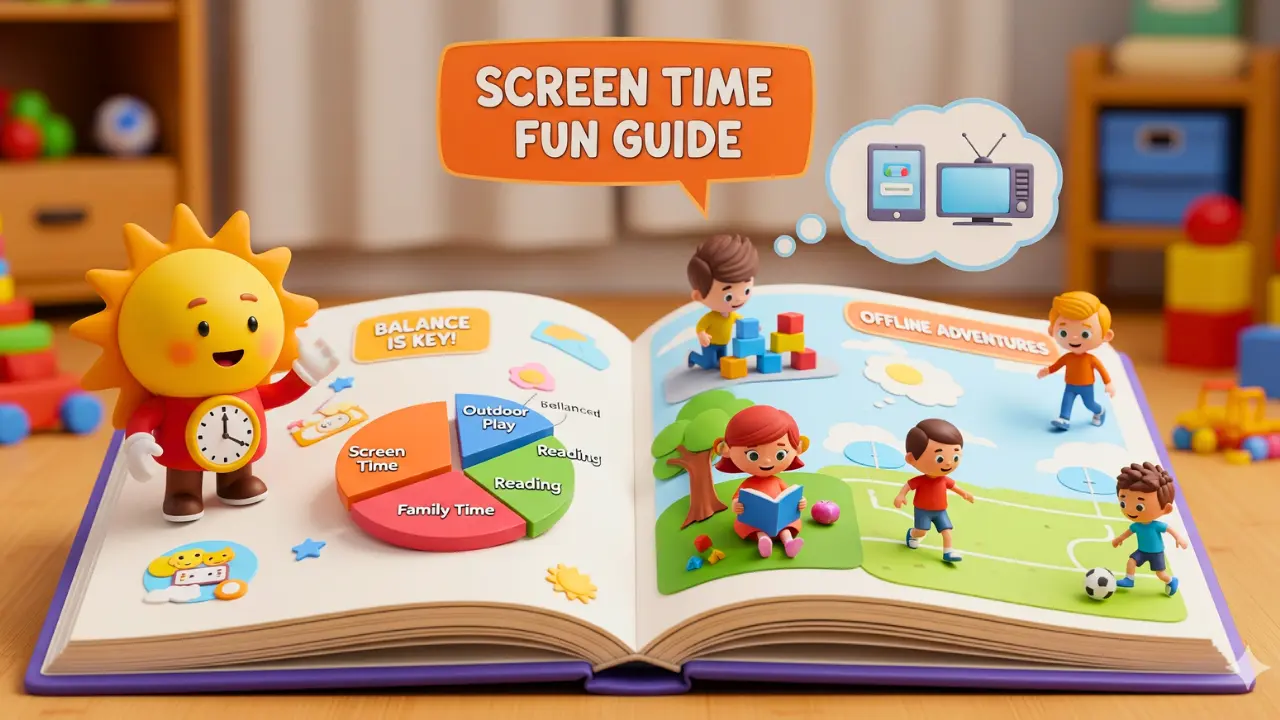Managing Screen Time for Kids: In today’s digital world, screens are everywhere. From tablets and smartphones to TVs and video games, technology has become an undeniable part of our daily lives. While these devices can be powerful tools for education and connection, they also pose a significant challenge for parents: how to effectively manage screen time for kids.
If you’ve ever felt like a broken record, constantly telling your child to “put the phone down,” you are not alone. This guide is designed to empower you with the knowledge and practical strategies needed to find a healthy balance for your family. We’ll explore why setting limits is crucial, how to create a family media plan that works, and offer a wealth of creative, screen-free activities to spark your child’s imagination.
Why Managing Screen Time for Kids is So Important
The impact of excessive screen time on a child’s development is a topic of growing concern among health professionals and educators. While some media can be beneficial, too much of it can lead to a host of issues, from physical to emotional.
- Physical Health: A sedentary lifestyle linked to excessive screen use can contribute to childhood obesity and poor posture. Additionally, a study published in JAMA Pediatrics found that the average time children spend in front of screens increased from 53 minutes at 12 months to over 150 minutes at 3 years, a period that greatly exceeds expert recommendations. This prolonged screen exposure can also lead to eye strain and sleep problems due to the blue light emitted from devices.
- Mental and Emotional Well-being: Unsupervised or excessive screen time can expose children to inappropriate content, cyberbullying, and unrealistic social comparisons, which can negatively impact their self-esteem and mental health. It can also lead to attention difficulties and mood swings.
- Cognitive and Social Development: Unstructured, creative play is vital for developing problem-solving skills, social cues, and emotional regulation. When screens take up too much of a child’s day, they lose out on valuable opportunities for imaginative play and real-world interaction.
Creating a Family Media Plan That Works
A “one-size-fits-all” approach to screen time rarely succeeds. The most effective strategy is to create a customized family media plan. This isn’t about rigid rules but about establishing clear, consistent guidelines that everyone understands and agrees upon.
Step-by-Step Guide to Your Family Media Plan
- Start with the “Why”: Before setting limits, have a conversation with your children about why these rules are important. Explain the benefits of balancing screen time with other activities, like better sleep, more energy for playing, and a greater sense of connection with family and friends.
- Establish Device-Free Zones and Times: Designate specific areas or moments in your home where screens are off-limits.
- Mealtimes: No phones or tablets at the dinner table. This encourages conversation and connection.
- Bedrooms: Keep screens out of bedrooms, especially at night. This helps improve sleep quality.
- Homework Time: Screens should be put away to avoid distractions and improve focus.
- Set Clear, Age-Appropriate Limits: The American Academy of Pediatrics (AAP) offers clear recommendations:
- Ages 0-18 Months: Avoid screen media other than video chatting.
- Ages 18-24 Months: Parents should choose high-quality programming and watch it with their children.
- Ages 2-5 Years: Limit screen use to one hour per day of high-quality content.
- Ages 6 and Older: Consistency is key. You can use tools like Google Family Link or Microsoft Family Safety to set and enforce these limits easily. For older kids and teens, work with them to set daily or weekly screen time budgets, teaching them responsibility and self-regulation.
- Prioritize Quality Over Quantity: Not all screen time is created equal. Encourage your child to use screens for creative, educational, and interactive purposes, such as learning a new skill on a coding app or video chatting with a grandparent.
- Lead by Example: Kids are always watching. Be mindful of your own screen habits. Put your phone away during family time and show them that a life beyond the screen is fulfilling and fun.
Also Read: A Beginner’s Guide to Sleep Training Your Baby
Fun, Screen-Free Activities to Try
The key to reducing screen time is to fill the void with engaging alternatives. When a child has exciting things to do, they are less likely to seek out a screen.
Get Creative and Active
- Outdoor Adventures: Go on a nature walk, fly a kite, or start a family garden. Outdoor play is essential for physical health and curiosity.
- Arts and Crafts: Keep a “creativity bin” stocked with paper, markers, paint, glue, and recycled materials. Challenge your kids to build a robot from cardboard boxes or make their own comic book.
- Board Games and Puzzles: Family game night is a fantastic way to connect and build teamwork skills. Puzzles are also great for developing spatial reasoning and patience.
- Reading Adventures: Create a cozy reading nook and make a habit of reading together every day. Explore different genres and authors to find what sparks your child’s interest. For more ideas on fostering a love for reading, check out our post on [Fostering a Lifelong Love for Reading in Kids](link to an internal blog post).
The Power of Conversation
Perhaps the most important element of managing screen time for kids is open, ongoing communication. Talk to your children about what they are doing online. Ask them about their favorite games and shows, and genuinely engage with their digital world. This not only helps you monitor their safety but also builds trust.
When it comes to technology, it’s not about prohibition but about balance and education. By setting thoughtful boundaries, leading by example, and providing engaging alternatives, you can help your child develop a healthy and positive relationship with technology that will benefit them for a lifetime.
Conclusion
Successfully managing screen time for kids is a journey, not a destination. It requires patience, consistency, and a willingness to adapt as your children grow. By creating a family media plan, prioritizing quality content, and fostering a love for screen-free activities, you can empower your children to thrive in a digital age.
What are your biggest screen time challenges? Share your thoughts and tips in the comments below!

















